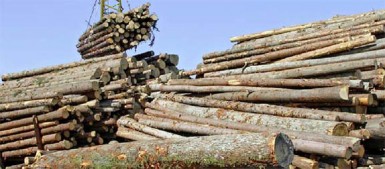Guyana’s forest resources contain a large diversity of timber species. A fraction of these species, for example Greenheart, Purpleheart, Kabukalli and Crabwood are very popular and are readily recognized for both their strength and aesthetic properties. The greater portions of these species which are referred to as Lesser Used Species (LUS) are not well known on the market. It is established however that many of the technical properties of the LUS are comparable to those of the more popular species.
The purpose of this article is to show how cost effective it would be for engineers, carpenters and joiners to start using the LUS. For demonstration purposes four (4) LUS have been selected and an attempt will be made to set out the possible uses of these species and make a comparison of the costs with the commercialized species. The four species selected are Black Kakaralli, Darina, Fukadi and Morabukea.
The price of lumber differs from one species to another depending on the value that people place on that species.

The more popular species are always in demand and since stocks are limited, these species get scarcer and this factor pushes the price upwards.
On the other hand there is a greater supply of LUS and this tends to keep the price lower than the commercial species. It should be noted that when comparisons are made between species they are generally grouped together to establish similarities in properties and other characteristics; for instance if we look at Darina (a LUS) which has a density 0.75g/cm3 when compared to Hububalli a commercial species, which has a density of 0.68 g/cm3 it can be seen that the two species have similar properties and should therefore have similar application usage. Hububalli is popular for applications such as furniture and building components. Darina is now gaining popularity for similar end user applications. However if an examination is made of the price of the two species it would be seen that Hububalli sells for approximately $250 per Bm whereas the average price for Darina is approximately $180 per Bm. Consider for example a piece of furniture such as an average size writing desk that consumes 40 Bm of lumber. Using Hububalli the cost of the lumber would amount to $10,000 whereas if Darina is used the cost of a similar quantity of lumber would amount to $7,200. This gives rise to a saving of $2800 without compromising the aesthetic beauty of the product. So, it would be extremely economical for craftsmen to start using species such as Darina in the manufacture of products of similar nature. Another factor that should be considered is the fact that Darina being in the same density category as Hububalli, makes machining just as easy for joiners and cabinet makers. Crabwood is also a heavily consumed hardwood used in the furniture industry, although it is classified in a heavier density category. It can just as easily be replaced by Darina for similar applications resulting in significantly lower costs and less wear and tear on the equipment.
Similarly it can be established that using Black Kakaralli for pilings instead of Greenheart can result in significant savings for the investor. It should be noted that Black Kakaralli has a density of 1.07g/cm3 while Greenheart has a density of 0.97g/cm3. One Greenheart pile with a length of 50ft can cost an average of $80,000 while the same length in Black Kakaralli can cost an average price of $70,000 resulting in a difference of $10,000.
This result in an economic advantage to the investor who decides to purchase Black Kakaralli for construction projects such as pile foundation.
A cost comparison for Fukadi a LUS, and Purpleheart when used for general construction such as sills, beams, and frames for a building will reveal significant price differentials. Both species fall within the heavy density category at 0.84g/cm3 and 0.86g/cm3 respectively. If it is assumed the quantity required for construction amounts to 1000 Bm, using Fukadi at a cost of $220 per Bm, the cost of the project would amount to $220,000. On the other hand the cost of Purpleheart at $380 per Bm would result in an expenditure of $380,000 for the same project. This example shows a cost advantage of $160,000 if Fukadi is selected for the project.
Finally the focus will be placed on Morabukea a LUS and Mora a more commercialized species which can be used in similar applications. Examples of such applications include decking used for patios and boardwalks as well as bridges and sleepers among other heavy oriented applications. Both species fall within the very heavy density category at 1.03g/cm3 and 0.95g/cm3 respectively. Both species have the same price range locally.
The advantage is the readily available supply of Morabukea which can be found in the forest.
Similarly, there are many other LUS that can be substituted for the more commercialized timber which would result in significant savings to the consumer.
It can be concluded that in any timber project the main factors that will be considered will be qualitative and quantitative, that is, how well the selected species will perform in service and how much the project will cost. Matching the right species with the correct application is important. Widening species use by incorporating the LUS into projects can have its cost advantages to the end users of wood.
A Forest Products Development and Marketing Council feature





